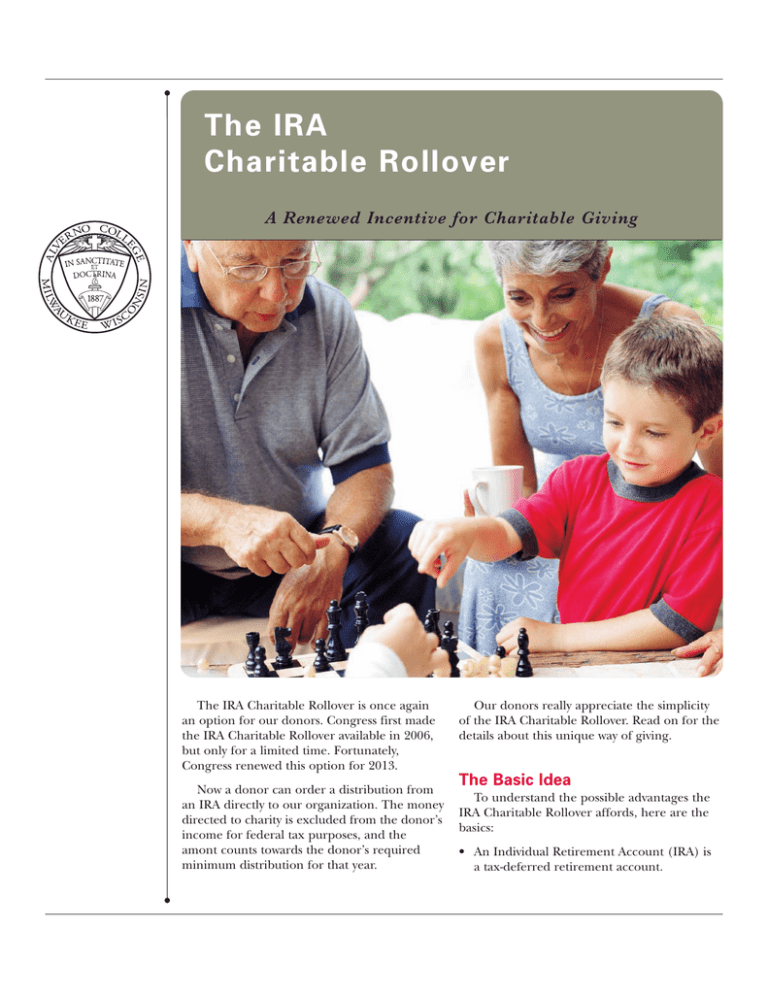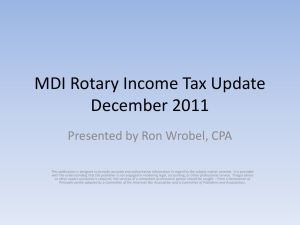The IRA Charitable Rollover A Renewed Incentive for Charitable Giving
advertisement

The IRA Charitable Rollover A Renewed Incentive for Charitable Giving The IRA Charitable Rollover is once again an option for our donors. Congress first made the IRA Charitable Rollover available in 2006, but only for a limited time. Fortunately, Congress renewed this option for 2013. Now a donor can order a distribution from an IRA directly to our organization. The money directed to charity is excluded from the donor’s income for federal tax purposes, and the amont counts towards the donor’s required minimum distribution for that year. Our donors really appreciate the simplicity of the IRA Charitable Rollover. Read on for the details about this unique way of giving. The Basic Idea To understand the possible advantages the IRA Charitable Rollover affords, here are the basics: • An Individual Retirement Account (IRA) is a tax-deferred retirement account. 2 • One contributes to the account and, for a traditional IRA, takes an above-the-line income tax deduction. • As IRA assets increase in value, the appreciation and earnings are not taxed. • However, once an amount is withdrawn from these accounts, the distribution is typically taxed as ordinary income (a marginal tax rate as high as 39.6% in 2013). Before the arrival of the IRA Charitable Rollover, the only way to make a lifetime charitable gift using IRA assets was to first withdraw an amount from the IRA, and then send the same amount to a qualified charity. As noted, the withdrawal would be taxed as ordinary income. The amount transferred to charity could be deducted by the donor (subject to deduction limits). Hopefully, the charitable deduction would successfully offset the income tax due on the withdrawal from the IRA account. • The donor can count the amount towards his or her required minimum distribution for the IRA — that is the amount required by law to be taken out of a qualified retirement plan account every year. • The donor will receive a 1099-R form from the IRA trustee to report the distribution. On the federal 1040 income tax return, the donor lists the qualified charitable distribution as non-taxable. Some Limitations The IRA Charitable Rollover offers important benefits to donors, but there are some limitations. Here’s a brief list to keep in mind: • Donors may not take an income tax charitable deduction for the distribution. • Donors may not direct the tax-free distribution to fund a gift annuity or a charitable remainder trust. Now, the IRA Charitable Rollover features one simple step: The IRA owner instructs the IRA custodian to transfer a specific dollar amount directly to a charity. It is that simple. The IRA owner does not include the IRA distribution as income. The charity immediately benefits from the gift — a simple transfer with an instant impact! The Basic Criteria Here are the highlights of the IRA Charitable Rollover: • The IRA Charitable Rollover provision is in effect until the end of 2013. • Donors must be 70 1⁄2 or older on the date of the distribution in order to participate. • Donors direct the distribution to a qualified charity like us. • The donor may exclude up to $100,000 with the IRA qualified charitable distribution. The IRA Charitable Rollover 3 • Donors may not direct the tax-free distribution in lieu of entertainment opportunities provided by the charity. • Donors may not direct the tax-free distribution to a donor advised fund or a Sec. 509(a)(3) supporting organization. To learn more about how the IRA Charitable Rollover fits into your plans, talk to your financial and tax advisors, or contact our office. We are glad to provide more information or answer any questions regarding this exciting development in charitable giving. • Donors direct the distribution from an IRA only (a traditional IRA or a Roth IRA, though there may be less incentive to use a Roth IRA since distributions are generally tax-free). Distributions made from a 401(k), 403(b), or 457 plan, etc. do not qualify. • Donors must direct a distribution that would otherwise be considered as taxable. The Next Step After consulting your financial and tax advisors to see whether the IRA Charitable Rollover is right for you, the next step is to contact the trustee of your IRA account and request the qualified charitable distribution. IRA custodians are aware of this option and may provide a written form in order to complete the transfer. Otherwise, you must send a written request to your trustee. Also, be sure to contact us to let us know to expect a distribution from your IRA account. Because the qualified charitable distribution requires substantiation just like a normal gift, we want to send you an acknowledgment that we have received the noted funds. Alverno College Carol Wacker, CFRE Tax information provided herein is not intended as tax or legal advice and cannot be relied on to avoid statutory penalties. Always check with your tax and financial advisors before implementing any gift. Office of Advancement Alverno College P.O. Box 343922 Milwaukee, Wisconsin 53234-3922 414-382-6468 Carol.wacker@alverno.edu www.alverno.edu IRA0313 The IRA Charitable Rollover





